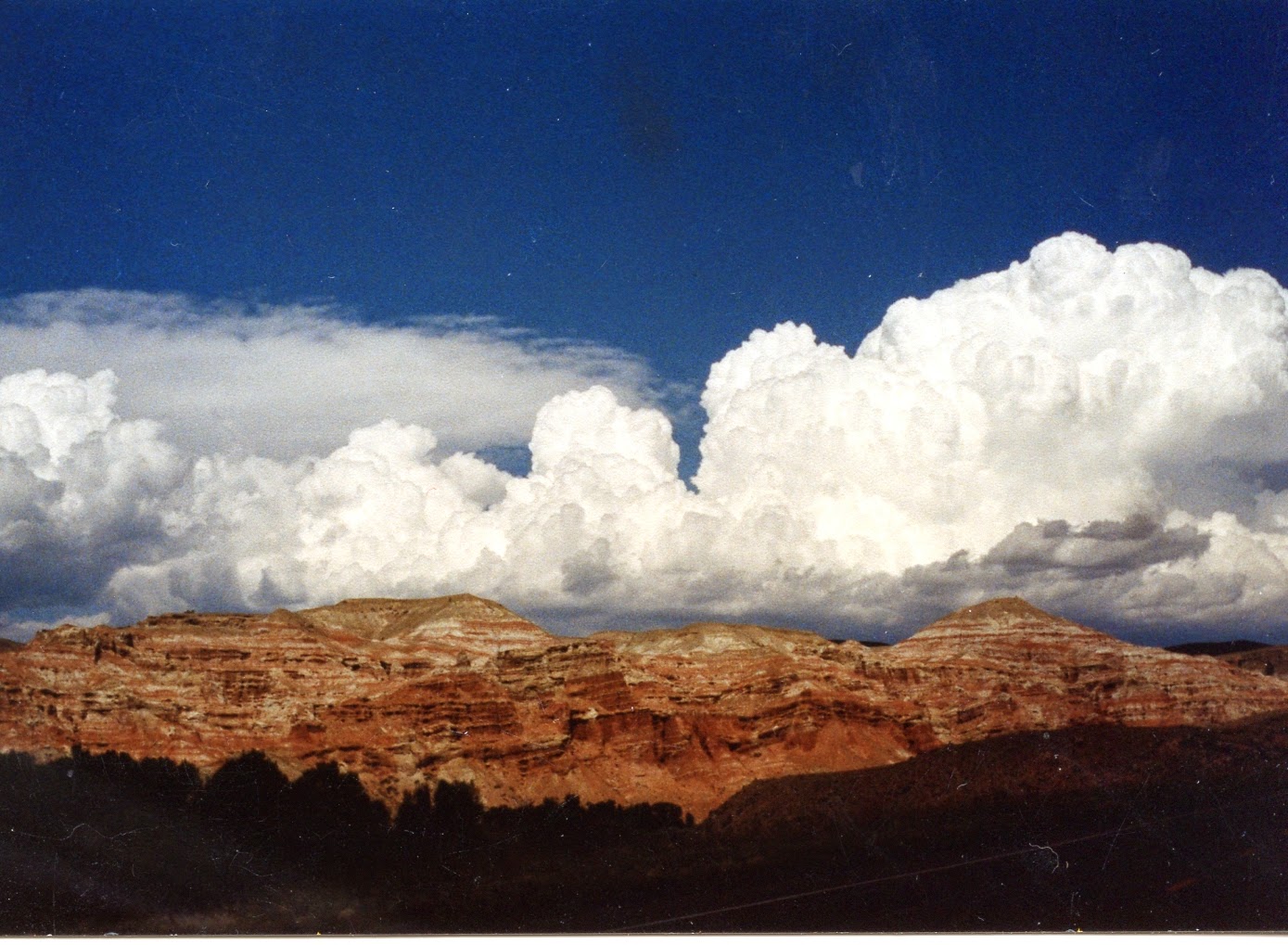Clouds
are a fascinating and important part of climate. During the daytime,
clouds keep us cooler, especially at high altitudes. At night,
clouds keep the earth warmer. Temperatures on a cloudy day into a
cloudy night drop less than if the clouds clear out.
Clouds
are made of condensed water or ice. They form when rising air cools
and water vapor clumps together forming droplets. The droplets will
remain as part of the cloud until they become too heavy and fall to
the ground as rain. If the temperature is cold enough, it falls as
snow or hail. The droplets need a solid surface to condense on--dust
or other microscopic particles in the air.
Clouds
appear white because their water droplets scatter all wavelengths of
light. (See the animated feature "Light and Colour" on
this blog for more information). Storm clouds are gray because they
are much thicker than white clouds and they block more light.
There
are many kinds of clouds--cirrus (curly or fibrous), stratus (flat or
layered) and cumulus (puffy and stacked up). After these three
groupings are other combinations, using cirro (high clouds), alto
(mid-level clouds) and nimbo (low level clouds). There are many
combinations of high/low and shapes. Some clouds have more than one
shape, resulting in names such as stratocumulus (partially flat and
partially fluffy).
 |
| Cirrus and Stratus clouds |
 |
| Cumulus clouds |
When
you see clouds moving, the wind is pushing them. The clouds can
travel great distances at high speeds with enough wind.
Clouds
produce three basic kinds of precipitation: rain, snow and hail. If
the precipitation does not reach the ground, it is called virga.
Also, there's the oft used term "snain" for rain mixed with
snow (weathermen don't use this usually.) Then there's sleet and
freezing rain. Sleet is composed of small ice pellets that hit the
ground. Freezing rain is snow that melts on the way down and then
freezes on roadways, trees, etc. Sleet is much smaller pellets than
hail and has different way of forming.
Rain
falls if the temperature is above freezing (0 degrees C, 32 degrees
F) all the way to the ground. If temperatures are below freezing,
snow falls. Sleet occurs when the snow melts on the way down, then
refreezes in the air before hitting the ground. Freezing rain (some
people call this an "ice storm") can make driving very
difficult due to slick roads and it can break trees limbs and power
lines if the ice gets thick and heavy enough. This is made worse if
wind is involved. The wind stresses the ice-covered lines and trees,
causing more damage than the ice alone.
 |
| Freezing rain |
 |
| Freezing rain |
Snow
is water droplets that freeze into flakes, generally with six sides
(not all flakes end up fully formed and some deform on the way to the
ground). It is said that no two snow flakes are alike. That may be
true because so many droplets of water are involved in the formation
of the flakes. It's not something we can really prove, but
mathematical calculations seem to back up the idea. Snow falling on
the mountains can build up and form or maintain glaciers. Glaciers
form when the weight of snow is great enough to create ice under the
snow. Mountain snow pack, which is the amount of snow left at the
end of winter, is important for people as it is used for drinking
water in some countries and for irrigation water. If snow melts too
quickly off the mountain, flooding can happen. The same is true for
large snow drifts anywhere. If the temperature rises too quickly,
the water has no where to go.
Hail
forms when wind pushes snowflakes back up into the clouds. The flake
picks up more and more ice and eventually becomes heavy enough to
fall to earth. Hail can ranges from BB size to grapefruit size.
Small hail can be very hard on paint and some plants. Larger hail is
damaging to most things. The size of the hail depends on the speed
of the updraft wind (wind pushing upward into the cloud). This is
one reason why you see large hail right before tornadoes--the wind
speed is high enough. Hail can be very dangerous. If you're outside
and hail starts, go inside or hide under something sturdy. The
larger the hail, the more the danger. Hail can fall at such a rate a
snowplough is needed to clear roads. Fortunately,
hail is one of the less common weather events.
 |
| Plowing hail with a snowplow |
There
are some special clouds: mammatus (low hanging bulges), lenticular
(disks that resemble flying saucers--these form over mountains) and
fog (a cloud on the ground).
 |
| Mammatus clouds |
 |
| Fog (from a distance) |
Next
time you notice clouds, take a moment to check them out. Clouds help
level out temperatures on earth and provide rain and snow needed by
people and plants. And they are just interesting to watch!

No comments:
Post a Comment